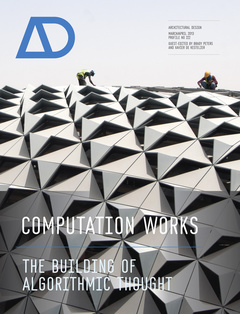Computation Works The Building of Algorithmic Thought Architectural Design Series
Auteurs : De Kestelier Xavier, Peters Brady

Architects are now taking advantage of the computer in new ways through experimentation with algorithmic and simulation-driven design. Computation Works: The Building of Algorithmic Thought focuses on this emerging theme in design practice, showcasing built and soon-to-be-built projects and providing a state of the art in computational design. Computational design is considered to be first a design tool, and second a series of instruments that can be applied in the creation of architecture. It allows architects to incorporate performance analysis and knowledge about material, tectonics and the parameters of production machinery. Moving towards a new role as hybrid practitioners, architects are taking concepts from other disciplines and customising architectural and other CAD software. In addition to the discussion of built projects, a further series of texts examines new custom software instruments. New digital tools provide new modes of representation, new methods of evaluation, and new techniques for design exploration. The development of new computational tools can create more responsive designs, allowing architects to explore new design options and to analyse architectural decisions during the design process. This issue raises important questions such as: How is computation changing the way architects design? Are the design tools and methods related to the result? What is computational design in the context of architectural practice? and How is computation changing the processes of design and construction?
EditorIal 5
Helen Castle
About the GUEST-EDITORs 6
Brady Peters and Xavier De Kestelier
Introduction 8
Computation Works: The Building of Algorithmic Thought
Brady Peters
Algorithmic Tectonics: How Cold War Era Research Shaped Our Imagination of Design 16
Daniel Cardoso Llach
Recent Developments at Foster + Partners’ Specialist Modelling Group 22
Xavier de Kestelier
Symmetry As Geometry: Kuwait International Airport 28
Kristoffer Josefsson
Mathematical Ensemble: Molteni Arc Table 32
Jethro Hon
Integrated Computational Design: National Bank of Kuwait Headquarters 34
Dusanka Popovska
Networked Space 36
Dennis Shelden
Spatial Computing for the New Organic 42
Christian Derix and Åsmund Izaki
Structural Emergence: Architectural and Structural Design Collaborationat SOM 48
Keith Besserud, Neil Katz and Alessandro Beghini
Realising the Architectural Idea: Computational Design at Herzog & De Meuron 56
Brady Peters
Simulating the User Experience: Design Optimisation for Visitor Comfort 62
Shrikant Sharma and Al Fisher
Bridging a Culture: The Design of Museo Soumaya 66
Fernando Romero and Armando Ramos
Interoperability in Sports Design 70
David Hines
From Model Thinking to Process Design 74
Jan Knippers
Navigating the Computational Turn 82
Ben van Berkel
Domesticating Parametric Design 88
Bruce Bell and Sarah Simpkin
Planning by Parameters 92
Jeroen Zuidgeest, Sanne van der Burgh and Bas Kalmeyer
After After Geometry 96
Michael Meredith
Embedding Intelligence: Architecture and Computation at Grimshaw, NY 104
Seth Edwards
Linking Structure and Parametric Geometry 110
Clemens Preisinger
Undrawable Architecture: Heritage Buildings and Digital Tectonic 114
Stylianos Dritsas and Kang Shua Yeo
Computational Fluid Dynamics for Architectural Design 118
Sawako Kaijima, Roland Bouffanais, Karen Willcox and Suresh Naidu
Design Ecosystems: Customising the Architectural Design Environment With Software Plug-ins 124
Daniel Davis and Brady Peters
Galapagos: On the Logic and Limitations of Generic Solvers 132
David Rutten
Kangaroo: Form Finding with Computational Physics 136
Daniel Piker
Pachyderm Acoustical Simulation: Towards Open-Source Sound Analysis 138
Arthur van der Harten
WeaverBird: Topological Mesh Editing for Architects 140
Giulio Piacentino
Geco™: Architectural Design Through Environmental Feedback 142
Thomas Grabner and Ursula Frick
Firefly: Interactive Prototypes for Architectural Design 144
Andrew O Payne and Jason Kelly Johnson
Contributors 148
Xavier De Kestelier is Associate Partner with the Specialist Modelling Group of Foster+Partners, where he has worked on a broad range of projects such as Beijing Airport, the Yacht Plus BoatFleet and the Masdar Institute of Technology. Originallyfrom Belgium, he gained an MArch from the University of Ghent and an MSc (Urban Design) from the Bartlett School of Architecture in London. Since 2006 he has been visiting professor at the University of Ghent (Belgium) and Syracuse University (USA). He is a Director at SmartGeometry, an international group of academics and professionals who promote the use of parametric and computational techniques in architecture through conferences and publications.
Brady Peters is an architect and researcher. Currently, he is a PhD Fellow at the Centre for Information Technology and Architecture (CITA) in Copenhagen Denmark. His current research focuses on the use of computation and parametric design tools in architectural practice. Originally from Canada, Brady Peters has a MArch from Dalhousie University and a BSc from the University of Victoria. In London he worked for Buro Happold and in 2003, he joined Foster + Partners, where he was a key member of the Specialist Modelling Group, and became an Associate Partner. He has taught architectural design at the Royal Academy of Fine Arts School of Architecture in Copenhagen, the University of Ghent, the University of Nottingham and has been a tutor at almost every SmartGeometry conference.
Date de parution : 04-2013
Ouvrage de 152 p.
20.8x27.4 cm
Thème de Computation Works :
Mots-clés :
Architecture and computer algorithmic design, architecture and simulation-driven design, Daniel Cardoso, Kaustuv DeBiswas, Christian Derix, Stylianos Dritsas, Sawako Kaijima, Neil Katz, Michael Meredith, Clemens Preisinger, Dennis Sheldon, Kai Strehlke, and Hugh Whitehead, Aedas, Buro Happold SMART, Fosters + Partners/SMG, Gehry Technologies, Grimshaw & Partners, Herzog and DeMeuron, Knippers Helbig Advanced Engineering, MOS, MVRDV, Populous, SOM/Black Box Studio, Sunglass, UNStudio



